Welcome to the inaugural post of my new blog (and website)! I am thrilled to tell you about Ecotone, which formalizes my professional consulting practice. With Ecotone as my vessel, I aim to embody the wisdom of Nature’s teachings, with confidence in the richness of intersectionality.
What is an ecotone?
In nature, the ecotone hosts the greatest variety of life of any ecosystem. By definition, an ecotone is “a region of transition between two biological communities” (Oxford Dictionary). Wetlands are famously productive systems that support a tremendous diversity of life. Why such richness? As ecotones, wetlands are edges between terrestrial and aquatic.

Who is Ecotone?
As a consulting vehicle for urban ecology practice, Ecotone aims to ensure that all beings who dwell in or near the built environment have a voice. We advocate strongly for native plants, bees, butterflies and birds, as well as beings who live in the waters, and try to communicate their needs with respect and care.
Human settlements support a great diversity of life, some are known; many are overlooked. The built environment is also home to a diversity of human hierarchies and governance. With over two decades’ experience working with green roofs, I am comfortable bridging gaps between disciplines. Further to that, I’m passionate to ensure that wildlife and water are considered in urban and garden design, green space planning, etc.
The full pivot to consultancy was inspired and motivated by the manifestation of some exciting projects. Projects that challenged my understanding and enriched my practice. I’m so grateful for the connections and relations established! With this first blog, I will reflect on these foundational projects – to the extent that I’m permitted – to give a flavour of what Ecotone can offer.
Projects of 2023
Green Roof Ecology, Vancouver Convention Centre living roof
For the growing season of 2023, I was part of an inter-disciplinary Team dedicated to enhancing the ecological value, resilience, aesthetics and performance of the 6-acre Vancouver Convention Centre (VCC) living roof.
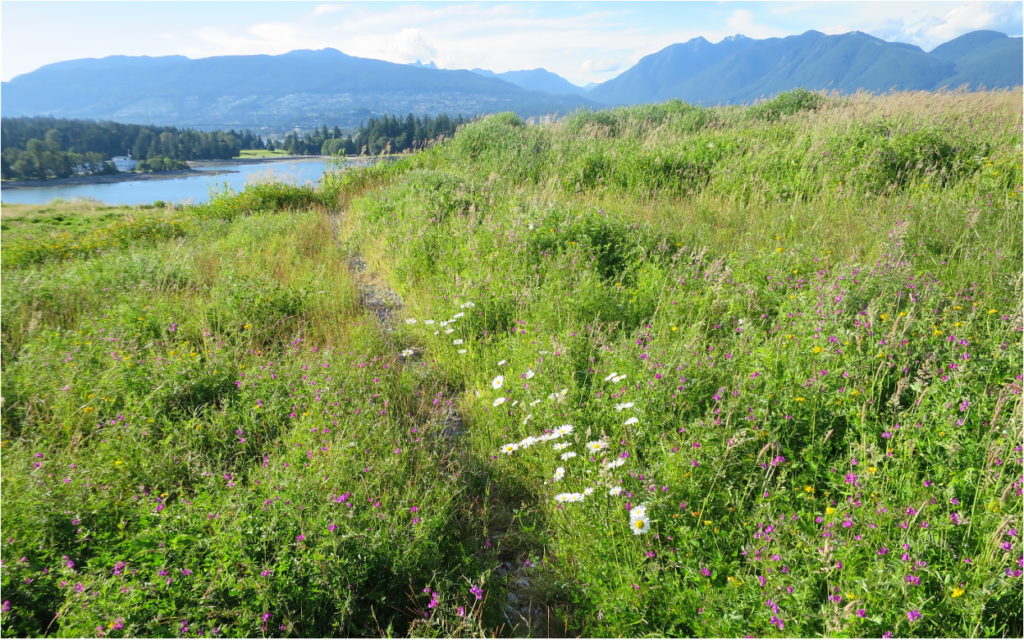
This 24,000 m2 (6 acre) green roof is truly superlative (learn more about it here). It was designed to replicate the meadow habitat characteristic of coastal British Columbia. In 2008-9, it was sown/ planted with 20 native species (including sedges, grasses, herbaceous perennials and bulbs). The building beneath is LEED Platinum, one of the highest standards in energy and environmental (green) buildings.
I spent the 2023 growing season conducting field work on this 14-year old roof. In addition to delight, I felt perfectly suited to do this unique work. For one thing, my PhD research examined the ecological dynamics of old extensive green roofs (find my thesis here; contact me for the peer-reviewed papers). This was am amazing opportunity to test out theory with practice.
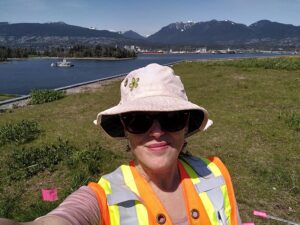
I was especially happy for the opportunity to assess the vegetation here because I’d worked at NATS Nursery when the plants were being grown. As Resident Ecologist and Green Roof Specialist, I was NATS’ liaison on the interdisciplinary team. The image below shows the test plots, which were closely monitored and helped make decisions that refined the actual planting (image taken May 2007).
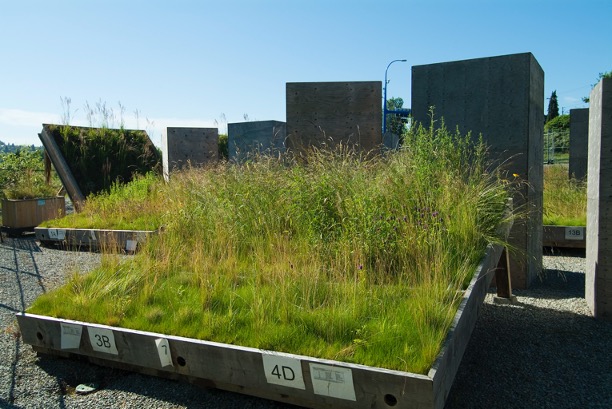
Back to 2023, as Green Roof Professional and Ecologist, I conducted floristic surveys to determine the current species composition of the roof, both intentional and unintentional. I designed field methods, conducted surveys, assessed the vegetation data, produced species lists and wrote two reports. I also guided maintenance for the invasive perennials that have established.
Change is the only true constant, and green roofs are as dynamic as any ecosystem. The photo below shows a recent newcomer to the roof, grape hyacinth (Muscari armeniacum). Nobody from our inter-disciplinary Team had noticed this species on the roof the previous year. Like most unintentional volunteers, it likely arrived with birds. In the photo (taken in April), note how the camas (not yet in flower), likely grazed by geese.
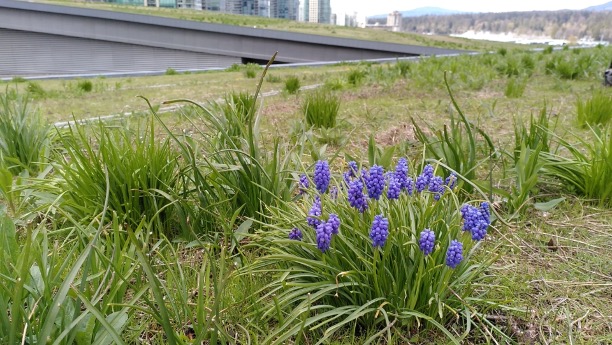
Plant list review, Oakridge Pollinator Meadow
When PFS Studio asked if I would review their plant list for the 3 acre pollinator meadow on the new Oakridge Centre, I was delighted, inspired, and awed. How wonderful that a landscape architecture and urban planning firm regards their planting design with such integrity! The brief: to review the plant schedule to ensure that it will, indeed, benefit native pollinators.

Yet another superlative green roof, the new “Oakridge Centre will be the largest development in Vancouver’s history” with a 9-acre rooftop park. At the time of writing, the skeletons of the new structures are rising from the Earth, slowly but surely. This development will change everything about this city and region. I can’t provide any details, so will leave it at this. Suffice to say that I did my best to give a voice to native bees, butterflies and birds, and am grateful for the opportunity to do so.
Urban ecologist and GRP, “Green Roofs Best Practices for Vancouver”
I was included on 2 of 3 bids for this project as the urban biodiversity consultant. The brief: to develop a best practices guide for green roofs in Vancouver. The guide is an extension of the City of Vancouver’s commitments to the Rain City Strategy, which recognizes green roofs as effective technologies for reducing and delaying stormwater runoff. The strategy commits to reducing total runoff by 90%, and recognizes green roofs as essential to achieving this ambitious goal.
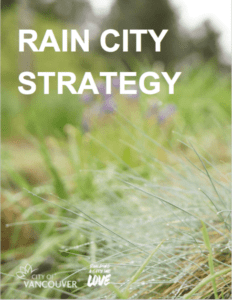
I am pleased to have been part of a fantastic inter-disciplinary team guided by the able leadership of PFS Studio. As the urban ecologist, I contributed original content for the appendices on plant lists and habitat enhancement. As a Green Roof Professional, I reviewed the content developed by the team to ensure rigour and correctness. At the time of this blog post, this project is in its final phase. Roll-out will take various forms, including a public-facing web-based resource.
Green Roof Professional, “Resilient Roofing” project with Community Energy Association
I’m pleased to be working with the Community Energy Association in developing content on “resilient roofing” for a semi-arid, fire-prone B.C. municipality. As a Green Roof Professional, I bring my established knowledge and experience, while also drawing from current research and understanding. It’s in process so I won’t say much about the project.
However, I’d like to share a bit about the body of current research I discovered that examines this question: What is the most economic roofing system for a hotter and drier future? What do you think?
- Cool roofs?
- Green roofs?
- Solar roofs?
- Blue roofs?
- Conventional roofs (e.g., gravel cover on asphalt/ bituminous waterproofing)?
Numerous studies have compared performance and costs of cool roofs, green roofs, blue roofs, and/ or solar-green roofs to conventional gravel roofs (e.g see here, here and here). The results are consistent and compelling. The best “bang for your buck”, including both investment and return, are solar-green roofs, as they perform better together, synergistically. Together, this combination of technologies is the definition of multi-functional. In addition to their synergy, solar-green roofs also manage stormwater, extend membrane longevity, support biodiversity, provide thermal insulation, reduce greenhouse gas emissions, mitigate urban heat island, etc.
The science is there. The real challenges are to discern and establish:
- the policy levers that will help to finance resilient and liveable cities (like San Francisco!), and
- the economic instruments that will help to establish a competitive and robust industry.
The photo below (taken 17 years ago) shows the massive green roof and solar installation at Basel Messe. I love how the Swiss get things done. Canada is notoriously sluggish on innovation and environmental stewardship, decades behind Europe. As a dual citizen, whose Swiss hometown is just south of Basel, I’m impatient for Canada to speed up on implementation.
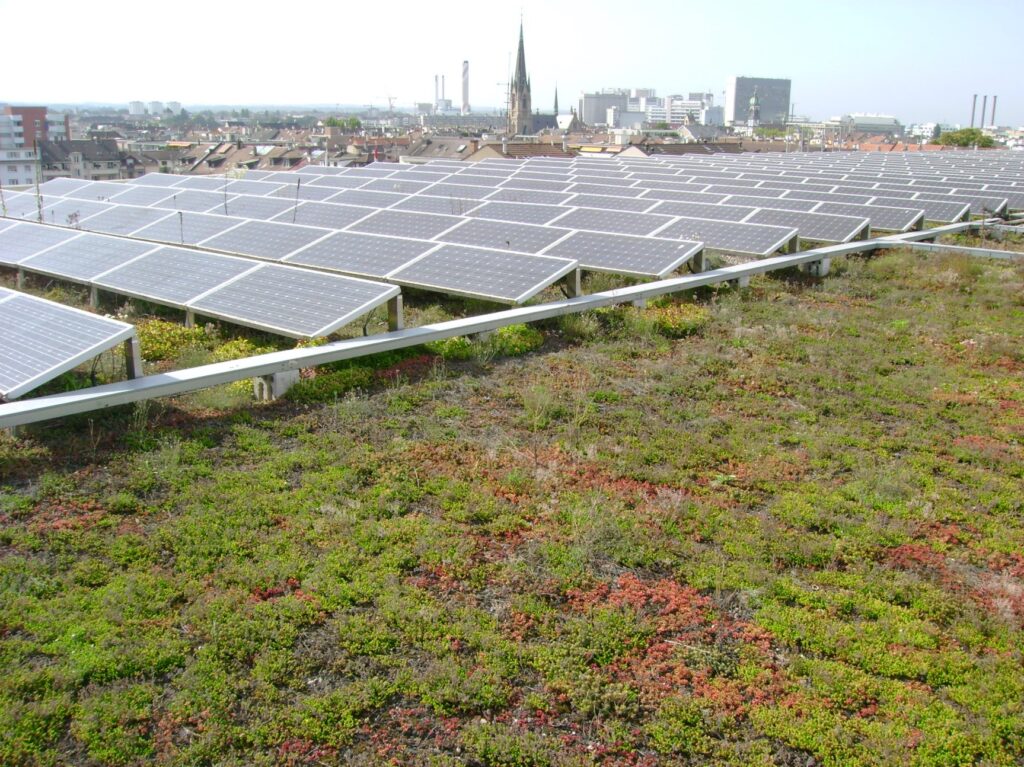
Closing thoughts
For 2024, I’m excited about new collaborations in intersectional practice and urban ecology. I am also committed to making progress on policies in B.C. that facilitate widespread implementation of green roofs and green infrastructure via GRIN (Green Roof Infrastructure Network). Please get in touch and let’s work together to usher in the changes in our landscapes and cultural practices that are long overdue. With Ecotone as my vessel, I am inspired to embody the wisdom of Nature’s teachings.
Massive gratitude to my friends, colleagues and family who have supported me on this journey, in all the different ways!
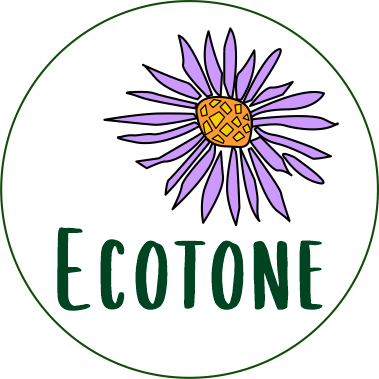
8 thoughts on “Embodying the Ecotone: Launching an Intersectional Consultancy”
Congratulations, Christine Thuring! It gives me hope, knowing that professionals like you are advocating for the wild creatures with whom we share this urban environment. Thank you for giving voice to them!
Thank you for your kind words, Ruth! I am doing my best, while constantly learning with much humility. Having a voice is a big responsibility and using it skilfully, in a good way, feels like an important training.
Congratulations Christine, Wow, you know so much and have done so much in this field! Seems you were born to do this. I look forward to reading (and learning) a lot more.
Thank you, Aarin. There is more to come!
Excellent and having known for so long great to see a fellow green roof person with a real interest in biodiversity leading the way
Thanks, Dusty, your words mean a lot! I admire what you have done for biodiversity on green roofs in London, and hope that my efforts may bear fruit, too.
Fantastic, Christine! Congrats on your website, blog and business. And thank you for doing great work for the world.
Thank you so much, Kim!